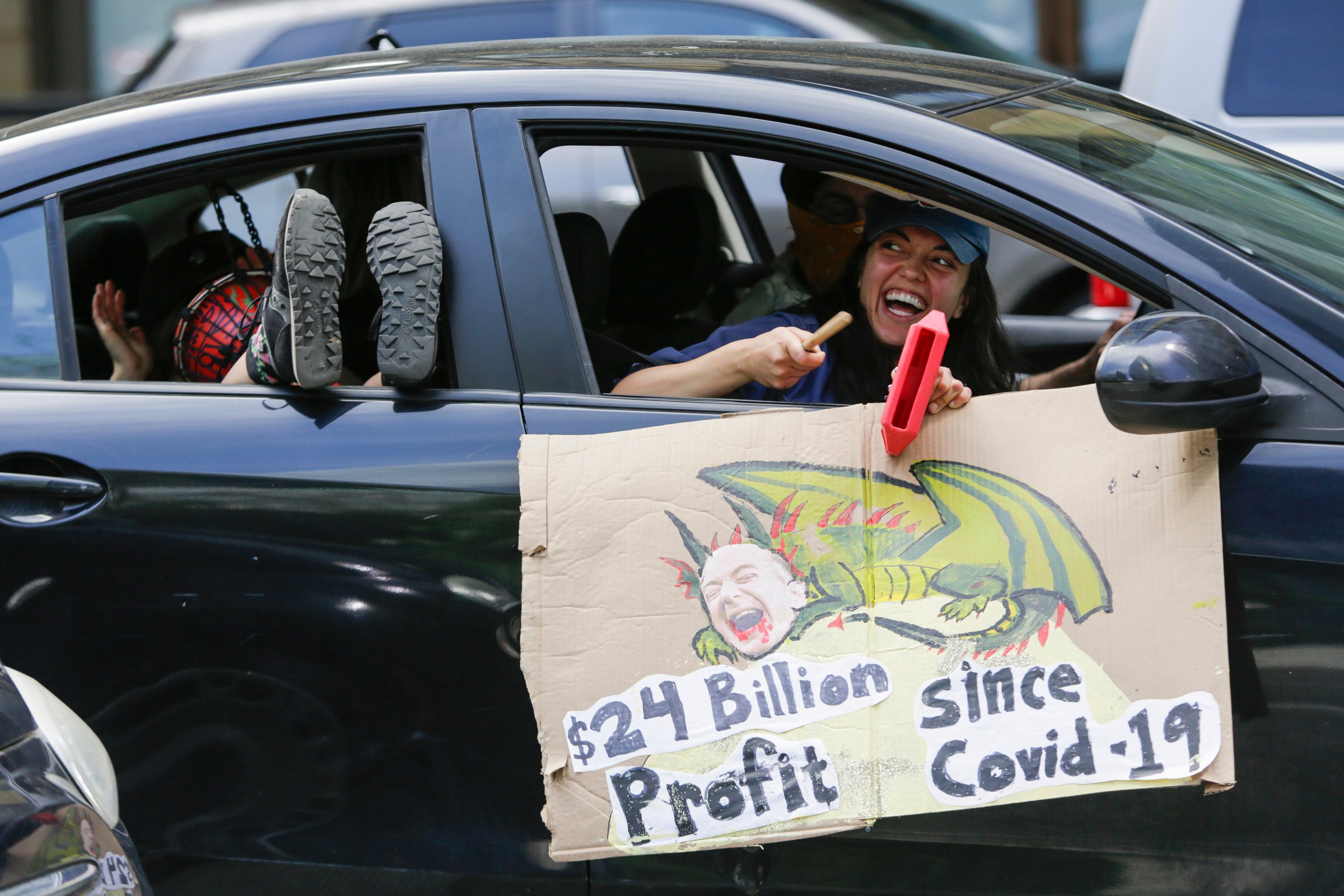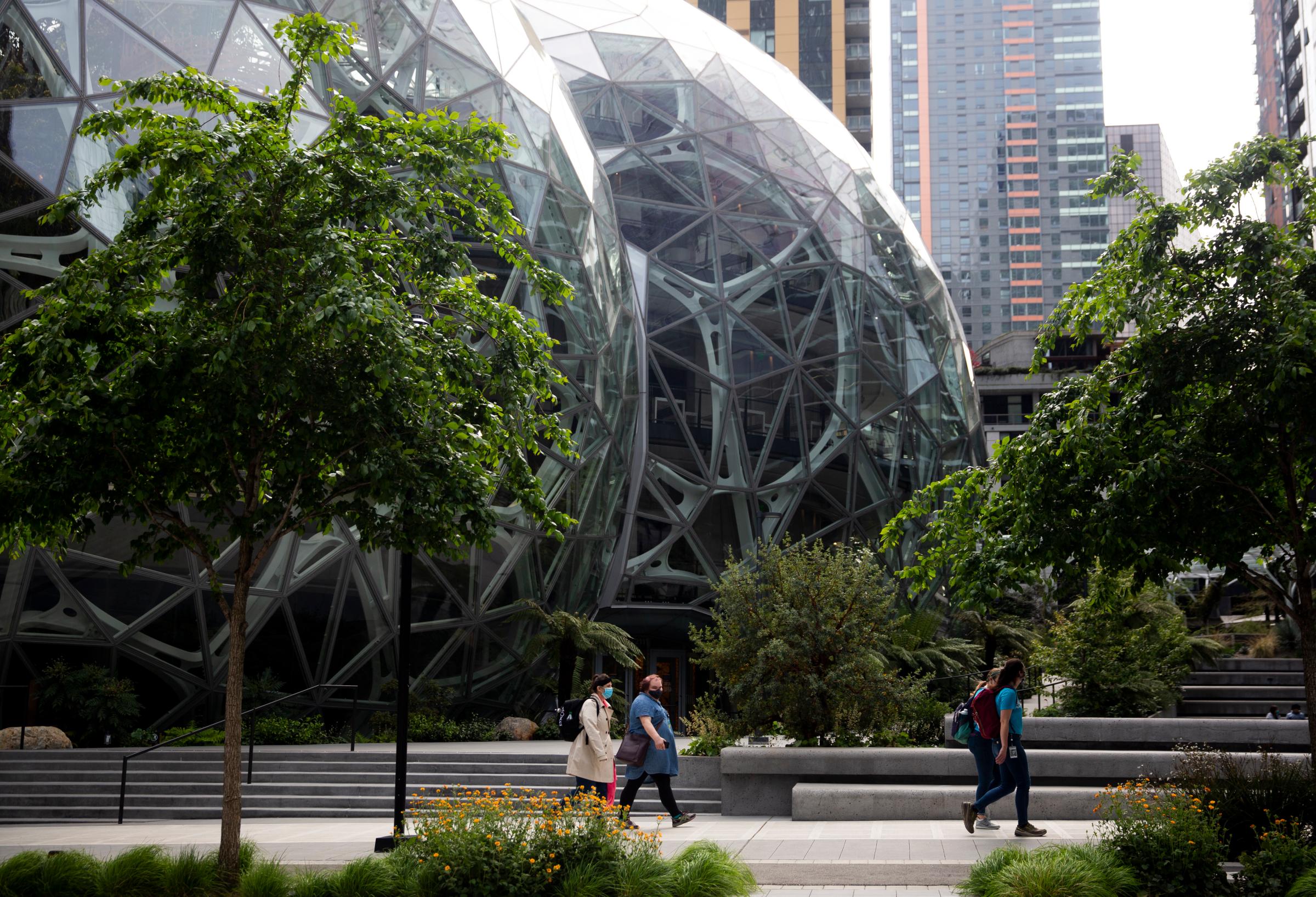
The pandemic has upended businesses across the world, but it has been very good for Amazon. Every lockdown “click to purchase” nudged the company a little further toward utter domination of online shopping as total e-commerce sales nearly doubled in May. But if bigger was better for everyone, Amazon founder and CEO Jeff Bezos would not be appearing before Congress on Wednesday for an antitrust hearing.
Charlene Anderson, and sellers like her, are one reason why he’ll be there. Anderson is among the many merchants who sell goods on Amazon — and who together account for more than half of sales on the site. But they pay, too: Amazon charges Anderson a $39.99 monthly fee to post her knitting and craft supplies on its site, and it takes a cut of about 30 percent on each item she sells. Anderson’s seller experience has worsened during the pandemic as Amazon exercised the power of what she calls “dictatorship” over the vast internal marketplace it alone controls.
In mid-March, for example, Amazon notified sellers that during the pandemic, its warehouses would accept only household staples, medical supplies and “other high-demand products,“ but it failed to explain how it determined what it would accept. Anderson could still send some colors of knitting bags to Amazon warehouses, but not others; she could send one size of knitting needles, but not another. Some sellers saw their sales evaporate; others paid USPS or other services to ship orders to customers, while still paying Amazon’s monthly fees.
Even after Amazon lifted that order, boxes of goods that Anderson ships to a warehouse still sit on loading docks for weeks, she says, and when Amazon unpacks them, it miscounts the items, an error that takes Anderson days to remedy. The company sends customers the wrong items, then allows them to leave negative feedback on her seller page despite the error being Amazon’s, says Anderson, who is 63 and lives in Jackson Hole, Wyoming. In the Facebook group she runs, Anderson says some sellers worry that the raft of problems will lower their internal scores on Amazon so much that the company will kick them off the site.
But where else can they go? “What are we going to do, protest and not sell on Amazon?” Anderson asks. “Right, I’m just going to kill my whole business. They have you and they know they have you—if you go, they’ll just find someone else to sell those products.”
Consumer spending on Amazon between May and July was up 60% from the same time frame last year, according to the financial data firm Facteus. The company’s extraordinary power — it has 38% of the e-commerce market, trailed by Walmart with 6% — was under scrutiny well before COVID-19. But the lockdown that boosted the company’s dominance also threw into higher relief its consequences for other businesses.
That’s increased interest in updating federal laws written more than a century ago to correct the distortions of monopolies on an economy. Bezos is appearing before a Subcommittee on Antitrust, Commercial, and Administrative Law, part of an investigation by the House Judiciary Committee into online platforms and market power. The hearings are asking: in the age of Big Tech, how big is too big? New York University marketing professor Scott Galloway, a longtime critic of Amazon, says it’s helpful to think of Amazon’s Prime membership service as the kind of massive competitive advantage once enjoyed by railroad barons. With its extensive logistics and delivery network, Amazon not only has the eyeballs of millions of households, it is the company that ships, packs, and delivers what they buy.
“Amazon already owns the rails into 115 million households in America,” says Galloway. “Do we really want one company to be the arbiter of all commerce?”

Economic crises have a way of creating winners and losers. Procter & Gamble thrived during the Great Depression by doubling down on advertising; Target expanded after the 2001 recession and saw profits grow 50%. Before the pandemic, Amazon represented around 4% of total U.S. retail sales. But with the new habits formed during the pandemic, UBS predicts that by 2025, e-commerce will make up one-quarter of total retail sales, up from 15% last year. The firm also estimates that 100,000 brick and mortar retail outlets will close in the next five years. “Consumers are increasingly shifting towards online shopping,” analysts wrote. “Many of these shoppers may not get back to in-store shopping when the current state is over.”
Amazon, which refused to make an executive available to comment on this article, casts itself as a friendly giant in its ubiquitous messages to consumers; it spent nearly $7 billion advertising itself in 2019 (more than double what Walmart spent). According to Ad Age, that made the company the biggest ad spender in the U.S. last year. But Amazon also sells advertising — $3.9 billion worth in the first quarter of 2020, up about 44% from a year earlier. The ads appear on Kindle, on Amazon Prime TV and on Amazon.com, some of them purchased by the same small sellers already paying to be listed on Amazon but afraid of getting lost on the site without additional promotion.
Because of the way e-commerce works, advertising on Amazon is essential for just about anyone selling on the site. According to marketing surveys, when online shoppers are thinking of buying an item, about half go straight to Amazon and search for the item, rather than Googling it or visiting another website. Most don’t scroll beyond the first page of results, so for sellers, it’s essential to be featured on that first page. They can hope that positive reviews lead Amazon’s algorithm to put them there, or they can buy ads.
Amazon is now the third-biggest digital ad seller in the United States, following Facebook and Google. And as it consolidates its grip on e-commerce, it can charge more for ads on its site. Buyers now compete with each other in an auction for keywords related to their products; the more people that are competing, the higher prices go. Revenues from advertising in the first three months of this year were up 43.8% from the previous year and 359% since 2017, according to company earnings reports.“It begins to feel like they’re playing chess, and they’re thinking three to four steps ahead,” says Andrew Lipsman, a retail analyst at market research firm eMarketer. “The more I think about Amazon, the more I marvel at it.”
So do investors, who saw its stock as a haven in a treacherous equity market. Amazon has gained half a trillion dollars in market value just this year, and shares should climb even higher when earnings are reported on July 30 if, as analysts at Goldman Sachs predicted, company revenues in North America show a jump of nearly 50% from the previous year. Bezos, already the richest person in the world with a net worth of $178 billion, could become the world’s first trillionaire by 2026.
That kind of concentrated wealth invites the stark comparisons embodied by people like Susan Bengel. One of the 175,000 employees Amazon hired during a pandemic that cost 40 million American jobs, Bengel, 62, had been living in her car before she started working at an Amazon warehouse in Pennsylvania in late March. She told me she recently got an offer from UPS, but she stayed with Amazon despite difficult conditions that include being on her feet for entire night shifts. UPS couldn’t match the pay or benefits she gets at Amazon, Bengel says. “It’s a monopoly, but they provide well,” she told me after one shift, in which each worker received a Chick-fil-A boxed dinner and bottle of hand sanitizer courtesy of Amazon. As stores close in her hometown of Wayne, Pa., she turned to Amazon to buy what she needs, including new shoes and back braces to get her through her shifts.

For Amazon shoppers, there’s not much not to like, apart from the unease at feeding a behemoth that competitors say is gobbling up their customers. Amazon argues that it’s not a monopoly, since it competes with brick and mortar stores for sales. “There’s a single retail market of which online is one channel. People do not shop exclusively online,” an Amazon spokesman said in a statement. But stores without Amazon’s logistics network are finding it impossible to compete. While Amazon was hiring tens of thousands of new workers, Jeff Curtis was running around his Maine bookshop, Sherman’s, scrambling to fulfill online orders much as Bezos had done in the mid-90s during Amazon’s early days selling only books online. But Curtis was by himself, because his store was closed to comply with stay-at-home orders. He says the state denied his request for special dispensation to bring in workers to help, even as Amazon was allowed to have on-site employees fulfill its own rush of online orders. Curtis has already decided to permanently close one of six branches of his store and is worried he may have to close another. It is the way of the world Amazon has built. Kathy Gonzalez, who runs two retail stores in northwest Florida, says she’s tried to offer shipping for furniture and other items she sells, but the cost is so high that people turn to Amazon, where shipping is free.
“If you want to be able to reach customers online, you’re essentially compelled to be on Amazon’s platform, but Amazon’s platform is not a place that you can succeed,” says Stacy Mitchell, the co-director at the Institute for Local Self-Reliance. “With this sudden surge in online shopping, all of that has been magnified.”
Its mammoth size gives Amazon advantages available only to itself: One of its companies, Amazon Web Services (AWS), is a cloud computing platform that lets companies rent space on a network of servers. Its $35 billion in sales in 2019 (up 36% from the previous year) provided a financial cushion that let Amazon subsidize grocery delivery, expand its network of warehouses, and dare to offer one-day shipping without worrying about huge losses. The company now has 1,223 buildings covering 278 million square feet in its global logistics network, up 82% since 2016, according to MWPVL International, a supply chain and logistics consulting firm, and it’s still expanding at an “unprecedented” pace,” says Marc Wulfraat, founder and president of MWPVL. It built or announced plans to build 49 million square feet of logistics space in the U.S. between March and July alone, he says.
Amazon’s deep pockets are also ensuring the company’s ability to operate during the coronavirus in a way no other company can. Bezos said in late April that Amazon was investing $4 billion in coronavirus-protection efforts, including personal protective equipment for workers, enhanced cleaning at facilities, and development of its own COVID-19 testing capabilities. Galloway calls this the first “vaccinated supply chain,” and says it will help Amazon further dominate competitors as more people choose to buy and sell products through a service that has invested in being virus-free.
Amazon also continues to invest in technologies that will further consolidate its grip on e-commerce. In June, the company said it would spend $1.2 billion to acquire Zoox, a startup that makes self-driving vehicles, which could help in its delivery services. Amazon is expanding its fleet of cargo planes as other airlines lease them for cheap, the better to lessen its reliance on FedEx and UPS. It invested hundreds of millions of dollars in Rivian, an electric car company, and ordered 100,000 electric vans from the startup. In July, Amazon said it would open more cashier-less Amazon Go stores.
“Some people—and I’m one of them—only buy something if it’s on Amazon” says Brandon Fishman, CEO of VitaCup, which sells vitamin-infused coffee and tea both in retail stores and online and which saw a 35% increase in its Amazon sales in March and April. Fishman says it’s cheaper for him to sell his products in brick and mortar stores than to sell them on Amazon, because of the cut Amazon takes for packing and shipping. But he doesn’t want to miss out on e-commerce customers, who are his most loyal. More than half the people who buy VitaCup products on Amazon return to the site to buy more.
“Third party sellers would say it’s a deal with the devil,” says Galloway, the NYU professor. “Amazon brings us a lot of revenue, and we become addicted to it, but every year our economics get worse.”
In April, the Wall Street Journal reported that Amazon had been using data from third-party sellers to determine which items were selling well, then making private-label versions of the same products to compete with the sellers’ products. (Amazon said such a practice would violate its policies, and it vowed to investigate.) Other sellers have alleged that Amazon does not take down counterfeit versions of items sold on its site; they suspect that the company does not want to lose the fees it collects from both legitimate and non-legitimate sellers. (Amazon says it invests “heavily” in prohibiting the sale of counterfeit products, using automated systems to help ferret out counterfeits, and that 99.9% of all pages visited by customers did not receive a notice of potential counterfeit infringement.)
During the pandemic, sellers say, communication has worsened and Amazon has slowed its response to flagrant problems on the site. Charlene Anderson says she can’t sell a knitting gauge because the picture is inaccurate on Amazon’s catalog page; she has been trying the problem fixed for three months. In July, Anderson says, Amazon told sellers it was going to restrict how many products they could keep in warehouses based on a performance metric. The ups and downs of the pandemic have meant that while Anderson’s sales were down in the beginning of the COVID-19 outbreak, they’re up about 3% now. But some sellers in the Facebook group she runs report their sales are down more than 50%. Most frustrating for all of them is the inconsistency; they have no idea when Amazon will change the rules again. “We hate having to deal with all of this, but to build our business, we have to,” Anderson says.
Amazon says its platform allows anybody to make an income in an otherwise challenging pandemic economy, and that it is working to help sellers while meeting increased demand from consumers. “Our commitment to our selling partners has never been more steadfast,” an Amazon spokesperson said in a statement. In the twelve months ending May 31, 2020, small and medium-sized businesses sold 3.4 billion products, up 25% from the same time the previous year, according to a report Amazon released July 21. Amazon says the average American small and medium-sized seller had more than $160,000 in sales during that time, though it did not provide averages for how much these sellers took home after expenses.
Amazon is now valued by the stock market at $1.5 trillion, a figure that dwarfs the GDP of Saudi Arabia. The very thing that has made it so successful during the pandemic—its size and the many layers of its businesses—is what has given it so much leverage over sellers, workers and governments. Existing antitrust laws are designed to protect the consumer from predatory pricing. That orientation has shielded Amazon, because the company in many cases saves consumers money, but it is being questioned by scholars, and now lawmakers.
Critics say that regulating or breaking up Amazon will be better for merchants on its site and also, in the long term, for the economy. The rate of start-up creation in the United States has been falling for years; there is some evidence that this is because big companies like Amazon use their size to force smaller competitors out of business, or prevent them from being created in the first place. If small manufacturers and retailers had a fighting chance in competing with Amazon, they might help reverse the decline in start-up creation. New businesses in America are much of what drives the country’s productivity and economic growth, raising its standard of living and spreading wealth and jobs.
Historically, antitrust enforcement has helped upstarts; Companies like Google arose in part because of government antitrust action against Microsoft in the 1990s; the breakup of AT&T in the 1980s helped launch a technology renaissance.
“A key component of our success as a society is this very basic notion of checks and balances,” says Galloway, of NYU. “We’ve tried to avoid dictatorships, we try to avoid monopolies. We don’t have a judge, we have a judge and jury. And we believe in the wisdom of crowds.”
Charlene Anderson agrees. She says she and other sellers don’t want Amazon to disappear. If that happened, they would lose their income source and their access to millions of shoppers. They just want better communication with Amazon, more democracy, less dictatorship. “Amazon is not transparent at all,” she says. “Amazon will not tell you anything.”
Wednesday’s hearing before the House subcommittee on antitrust law will test that allegation, and more, as Congress peaks behind the curtain of one of America’s most successful companies. The next question is whether it has the tools to do anything about what it sees.
More Must-Reads from TIME
- Introducing the 2024 TIME100 Next
- The Reinvention of J.D. Vance
- How to Survive Election Season Without Losing Your Mind
- Welcome to the Golden Age of Scams
- Did the Pandemic Break Our Brains?
- The Many Lives of Jack Antonoff
- 33 True Crime Documentaries That Shaped the Genre
- Why Gut Health Issues Are More Common in Women
Contact us at letters@time.com